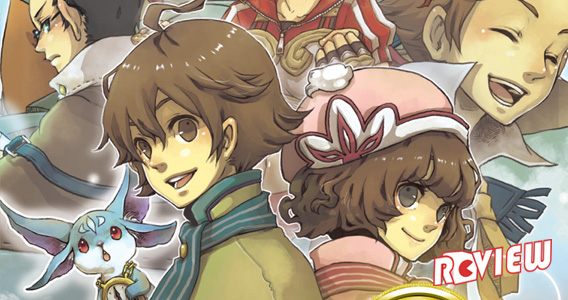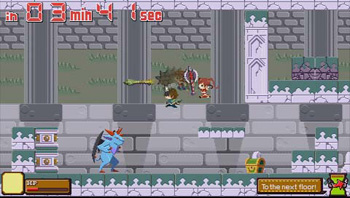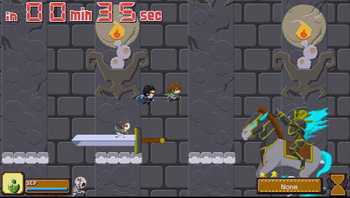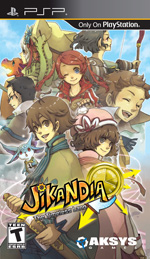
The concept of time travel has been used as a plot device in videogames time and time again, often with sterling results. From Square’s masterpiece, Chrono Trigger, and its follow up, Chrono Cross, to more recent fair such as Atlus’ DS release, Radiant Historia, time travel is nothing new for the medium. And yet as memorable as those titles are, no videogame that I’ve played to date uses the concept of time quite as effectively as Jikandia: The Timeless Land.
On the surface, the story is simple enough. You play a typical high school student who, along with eight of your friends, is magically transported to another world during your daily commute to school. You come to learn that you have been summoned to the world of Jikandia to help save it from destruction. Jikandia, until very recently, was devoid of time – that is until a crop of monstrous baddies began popping up, bringing with them the concept of time, which threatens to unravel the world of Jikandia with the resulting chaos.
In order to get back to your own world, players must uncover the origins of these vile monsters, eliminating them and restoring Jikandia the timeless land to its former state.

The game plays as a hybrid action RPG/platformer, one that takes many design cues (both visually and mechanically) from a decidedly retro vein. This is not overly surprising, considering that developer Opus’ previous effort was the brilliant and time concerned Half Minute Hero. And much like Half Minute Hero, Jikandia represents the perfect balance of retro charm and new school sophistication.
The most interesting aspect of Jikandia, by far, is how it manages to take its bizarre story of a time-free world and apply it so purposely to the game-play, creating an absurdly clever hook.
As you progress through the game, you travel to different locations in search of those responsible for the influx of time to Jikandia. The levels themselves are colorful, imaginatively populated, have no set length, and are randomly generated with each play-through. At the onset of each level players are able to choose the amount of time to finish said level, anywhere from 3 and 30 minutes. On the surface this may seem like an easily exploitable gimmick; just pick 3 minutes for every level and zip through the entire game.

The balance achieved in Jikandia means that trying to decimate every level as fast as you can isn’t really possible. The difficulty ramps up to such a degree between each level that spending 30 minutes in an already cleared area is ripe with benefits. The treasure you collect, the enemies you kill, and the tasks you accomplish in each stage affect the amount of in-game currency you are awarded at each level’s conclusion. With the final minute and a half of each level reserved for the always challenging and wildly imaginative boss fights, you quickly learn that three minutes does not afford enough time to advance your characters effectively.
The simple and addicting gameplay is well accompanied by Jikandia’s simple yet effective character advancement system – the Quartz system. You are able to equip your main character with specialty items called Quartz crystals. These can mainly be purchased in Jikanida’s hub town, but are also rewarded occasionally within levels. The Quartz crystals grant you abilities such as increased HP, increased attack power, increased defense, etc. With a limited number of Quartz crystals to equip, it is essential that you strike the correct balance for any given situation. Finding that balance provides a surprising amount of depth within the confines of such a simple mechanic.

My sole complaint with Jikandia is not the story, which is well thought-out and rarely strays into the overly silly and absurd, but with the way in which the story is presented. At the start of each new stage your sub-characters start chatting away, but the problem is that, more often than not, I would start attacking enemies, finding treasure, and completing the game’s numerous timed actions while ignoring the dialogue all together.
This dialogue delivery is most certainly not helped by the fact that it appears one line at a time at the bottom of the screen, and it seems pretty out of place in a game that frequently emphasizes the importance of using time intelligently and effectively. I would have much preferred to have these dialogue scenes revealed when entering a new level, before the timer starts.
That is a very minor complaint though – I have a hard time faulting a game where the developers have crammed such creative level design, a mood-perfect soundtrack, and an absolute over-abundance of charm and imagination into a single UMD.
Idea Factory, Opus
Publisher
Aksys Games
System
PlayStation Portable
Modes
Singleplayer, ad-hoc multiplayer
Release Date
March 15, 2011
*A copy of this title was provided by the publisher for review

Interesting… not sure how this title flew under my radar…
Comment by Ujn Hunter — April 15, 2011 @ 3:32 pm
Funny thing is I tried the demo and didn’t like it… maybe I was playing it wrong or was in an off day? Did love the artstyle and music so maybe it’s time for me to jump back in this land and give it another go.
Comment by EdEN — April 15, 2011 @ 4:17 pm
Man thanks for hipping me to this game. Loved the arcade Castlevania-ness of the game. It was perfect for some quick hit gaming.
Comment by Matthew Morales — April 25, 2011 @ 2:41 am
Funny thing is, I couldn’t get into the demo either… the full game had a sense of charm that I couldn’t help but to get swept up it.
Comment by Anonymous — April 27, 2011 @ 4:42 pm